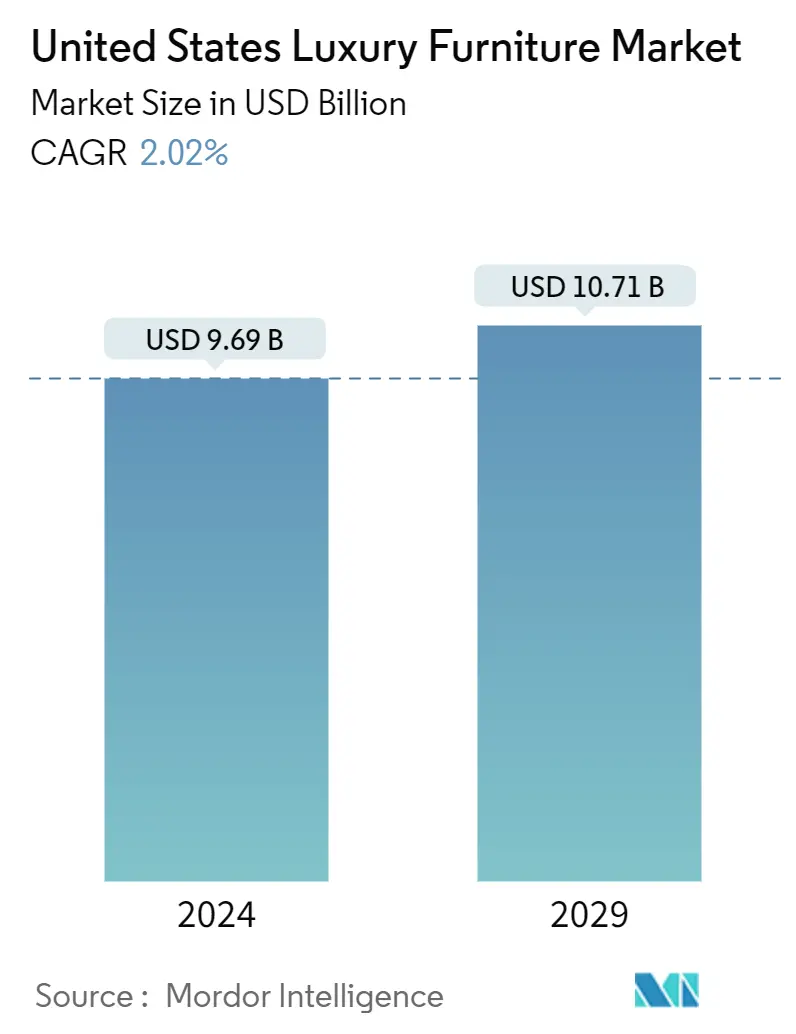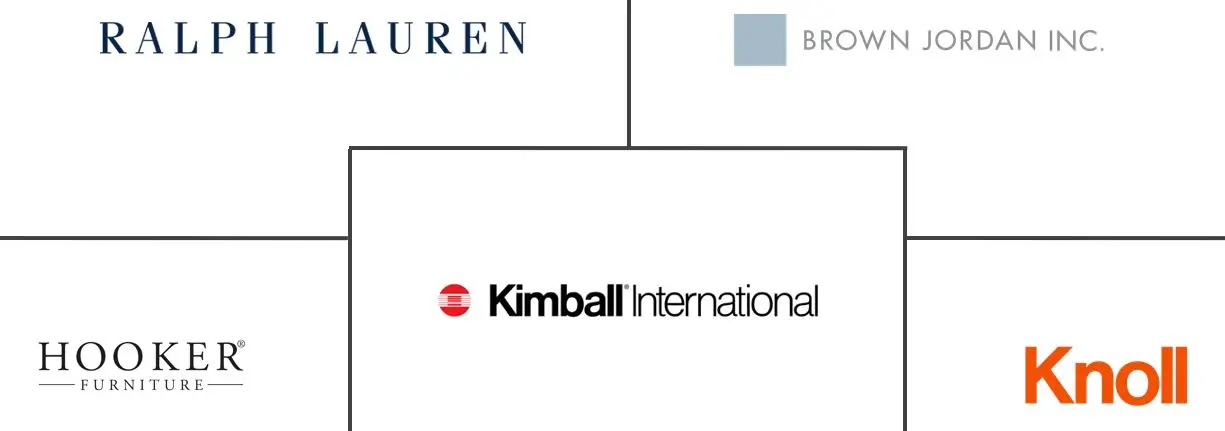Market Size of United States Luxury Furniture Industry

| Study Period | 2020 - 2029 |
| Base Year For Estimation | 2023 |
| Market Size (2024) | USD 9.69 Billion |
| Market Size (2029) | USD 10.71 Billion |
| CAGR (2024 - 2029) | 2.02 % |
| Market Concentration | Low |
Major Players
*Disclaimer: Major Players sorted in no particular order |
US Luxury Furniture Market Analysis
The United States Luxury Furniture Market size is estimated at USD 9.69 billion in 2024, and is expected to reach USD 10.71 billion by 2029, growing at a CAGR of 2.02% during the forecast period (2024-2029).
Luxury furniture enhances the aesthetic value of establishments, such as homes, hotels, offices, and other indoor or outdoor areas. The US luxury furniture market significantly benefits from the economic growth of the country. The rise in consumers' spending power and high demand for housing are the primary growth drivers of the luxury furniture market in the United States. Consumers in the region are inclined toward eco-friendly furniture, owing to the increase in environmental awareness. However, a rise in the costs of raw materials, such as wood and leather, may restrain the market growth. Online retailing and an increase in the demand for multifunctional furniture present significant opportunities for the growth of the US luxury furniture market. The demand for handcrafted authenticity, rather than mass-produced pieces is rising in the luxury furniture market and the use of metals in interesting ways is trending with colors turning away from rose gold toward gold, brass, or blackened metals, used in sculptural or massed ways. With real GDP expected to grow by 4.4% overall in 2021 as the trend of economic recovery continues across the United States, it is expected that the home furnishings industry will also witness strong growth in 2021, which will, in turn, give a strong boost to the furniture industry.
The luxury furniture industry has highly suffered the impact of the COVID-19 pandemic. It is expected that the market may take a longer recovery time, based on the concerns expressed by some luxury interior designers and furniture brands. One of the major impacts of COVID-19 on the furniture industry is on the supply chain. To overcome this hurdle, furniture brands need to develop an effective supply chain response plan to mitigate the risks and prepare for any further interruption that the COVID-19 outbreak may cause. The market for luxury experiences, like travel, dining, and entertainment, has grown at a much faster pace than that of luxury goods such as furniture in recent years nonetheless, this all came at a stall in 2020 amidst the pandemic situation. The furniture industry is also witnessing increased investments in 2021. For instance, Ashley Furniture Industries is confronting the United States furniture industry's challenges head on, unleashing the largest single investment in the company's 75-year history.
US Luxury Furniture Industry Segmentation
A complete background analysis of the market, including the analysis of market size and forecast, market shares, industry trends, growth drivers, and vendors, is provided. Additionally, the report features qualitative and quantitative assessments by analyzing the data gathered from industry analysts and market participants across key points in the industry's value chain. The Market is Segmented by product, distribution channel, and end-user. By Product, the market is segmented into Lighting, Tables, Chairs and Sofas, Accessories, Bedroom, Cabinets, and Other Products. By Distribution Channel, the market is segmented into Offline and Online. By End User, the market is segmented into Residential and Commercial. The report offers the market sizes and forecasts in value for the above segments.
| Product | |
| Lighting | |
| Tables | |
| Chairs and Sofas | |
| Accessories | |
| Bedroom | |
| Cabinets | |
| Other Products |
| Distribution Channel | |
| Offline | |
| Online |
| End User | |
| Residential | |
| Commercial |
United States Luxury Furniture Market Size Summary
The United States luxury furniture market is poised for steady growth, driven by economic expansion and increased consumer spending power. The market is characterized by a rising demand for eco-friendly and handcrafted furniture, as consumers prioritize aesthetics and quality. The trend towards multifunctional furniture and innovative use of metals is gaining traction, reflecting a shift in consumer preferences. Despite challenges such as rising raw material costs and the lingering effects of the COVID-19 pandemic on supply chains, the market is expected to benefit from the growing urban population and the demand for premium products. The hospitality industry also plays a significant role in driving demand for luxurious furniture solutions, with a notable focus on Italian-made products, which are highly regarded for their design and quality.
The luxury furniture industry in the United States is experiencing a dynamic landscape, with major international players dominating the market. However, technological advancements and product innovations are enabling mid-size to smaller companies to expand their market presence. The domestic segment is witnessing the most significant growth, fueled by urbanization and increased disposable incomes. Strategic partnerships and acquisitions, such as Ralph Lauren's collaboration with Theodore Alexander and Kimball International's acquisition of Poppin Inc., highlight the industry's focus on expanding product offerings and tapping into new markets. As the market continues to recover from the pandemic's impact, it is expected to see robust growth, supported by increased investments and a focus on quality and stylish furniture products.
United States Luxury Furniture Market Size - Table of Contents
-
1. MARKET INSIGHTS AND DYNAMICS
-
1.1 Market Overview
-
1.2 Market Drivers
-
1.3 Market Restraints
-
1.4 Market Opportunities
-
1.5 Impact of COVID-19 on the Market
-
1.6 Insights Into The Regulatory Framework and Import Limits and Tariffs Applied to Furniture Products
-
1.7 Industry Attractiveness - Porters Five Force Analysis
-
1.8 Value Chain Analysis
-
1.9 Technology Snapshot
-
1.10 Consumer Behavior Analysis
-
-
2. MARKET SEGMENTATION
-
2.1 Product
-
2.1.1 Lighting
-
2.1.2 Tables
-
2.1.3 Chairs and Sofas
-
2.1.4 Accessories
-
2.1.5 Bedroom
-
2.1.6 Cabinets
-
2.1.7 Other Products
-
-
2.2 Distribution Channel
-
2.2.1 Offline
-
2.2.2 Online
-
-
2.3 End User
-
2.3.1 Residential
-
2.3.2 Commercial
-
-
United States Luxury Furniture Market Size FAQs
How big is the United States Luxury Furniture Market?
The United States Luxury Furniture Market size is expected to reach USD 9.69 billion in 2024 and grow at a CAGR of 2.02% to reach USD 10.71 billion by 2029.
What is the current United States Luxury Furniture Market size?
In 2024, the United States Luxury Furniture Market size is expected to reach USD 9.69 billion.

